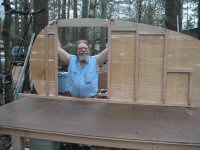Yota Bill wrote:John Palmer wrote:Yota Bill wrote:the problem with that way is that it will pull on both ends, and could bend the other end first...alignment or frame shops could do it, but they have systems to measure it, and ways of attaching it to a frame rack to pull only where they need to, instead of both ends
Bill, you can easiy direct "the pull" by where you place the jack under the axle.
yes, but you are still relying on the other side of the axle for leverage. Every action has an equal and opposite reaction. I'm not saying it doesnt work, as I have done it myself, but there is still a very good chance that the other end will bend some before the intended side is back into shape, being that it is bent close to one end.
Notned, go ahead and give it a try, you really dont have anything to lose. At this point, the axle needs replaced. If you can fix it without spending any money on it, then your ahead. If you try and cant fix it, you are out nothing but your time.
John Palmer, there is an easier way to check toe, without using the pieces of angle strapped to the tires, and relying on them to be straight. All you need is a couple jackstands to place under the axle (have the tires off the ground) 2 thumbtacks or pushpins, and a tape measure.
Stick the thumbtacks in the tire tread in the center of each tire(does not need to be extremely accurite, eyeball the center and stick it), then rotate the tires so the tack is pointing straight forward, and measure the distance. Now rotate the tires so the tack is facing straight rearward (rotate the tire, do not pull the tack out) and re-measure. The distance between the tacks when facing forward should be slightly less then when facing rearward. How much that difference is is dependant on tire size and toe in desired, but for an average size tire, 1/16 to 1/8 inch or so is OK.
Obviously, since it is an angle being measured, the further away from the center of the hub you get (larger tires, or using the angle you talked about) increases the distance at the rear and decreases the distance at the front (increased differential) without changing the angle (toe) at all. That does mean that getting further away from the axle centerline makes for a more accurite measurement, but it is still a "best guess" as to how much is needed. Camber can be measured the same way, as long as there is nothing in the way of measureing across the top of the axle.
I have a 6X8 "railroad tie" beam. I loop chain over each end (and the axle) and use a bottle jack in between the beam and the axle. I bend exactly where I want to. In the world of horseshoes and hand-grenades it really is pretty precise.
